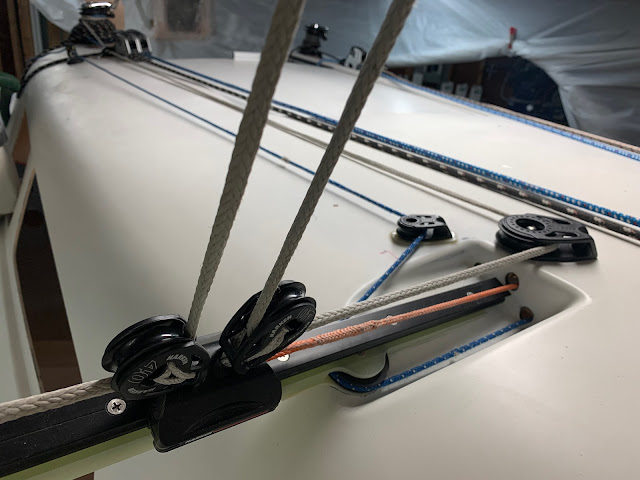Jib Inhauler Tracks
Without a clear design, or path in my head, the lead up to the impending holidays seemed like a good time to try to rough out my jib inhauler concept. The goal is BIG.
A performance jib-only boat like this needs to sail at somewhere between 6-11 degrees of sheeting angle in most conditions. If you have an interest in a blog like this, you know that the normal solution is to use either a fully floating lead, or a separate inhauler coupled with a longitudinal jib track. There are two massive setbacks to the state of the art. In both cases, it's almost impossible to recreate settings with any kind of consistency. If you move one rope, everything else needs to be tweaked and adjusted to get back to a reasonable sail shape. The other massive issue, especially for standard inhauler setups, is that the jib sheet and inhauler often nearly oppose each other. Anybody who has sailed a Farr 30 can tell you that the load is ridiculous as the inhauler and jib sheet fight.
My global goal, and this is important, was to try to create a system where one might drop the jib clew to leeward, much like one might drop the mainsail traveller, but with no change to the overall sail depth or twist profile. I also wanted to avoid sending the jib sheets to the bow and back, as it's done on many boats with self-tacking tracks. The system envisioned here does sacrifice active twist control, relegating it to moving a pin on a clew board, or sliding the headsail up and down the forestay. To be fair, both these tactics do work quite well on my I-14, but it's not something I've seen on a keel boat.
Let me dig deeper.
Step one was to draw the boat in 3D with the rig in the boat. Next I looked at the forestay as an axis of revolution for the jib. It turns out, if you hang a jib on the forestay in the model, then spin it 360 degrees, watching the path the clew takes, it will give you the specific orientation for the roughly transverse track. As one might imagine, the tracks must rake forward and raise up modestly at their outboard ends. Transferring the complex compound angle to the boat stumped me for a few days, until I got the idea to make a jig out of MDF based on my study in Rhino.
With the boat leveled, and the jig in place, I cut several prototype supports out of MDF to test and improve the design. It took some trial and error to figure out how to get the inhauler rope to pass underneath the offside track without fouling on the doghouse rebates.
The whole thing is hard to explain, so I will let the video do the talking. Yes, there needs to be some kind of legs or support under those shin-killing tracks, but that will be for another day down the road.







Comments